March 24, 1991 to May 9, 2011

Whether they live long and peaceful lives, or leave unexpectedly, far too soon, it’s always painful to lose one of our animal companions. While my work emphasizes the special gifts of horses in particular, some of the things I’m about to say are relevant to dogs, cats, birds and other species who form lasting bonds with people. And so, in this tribute to my greatest teacher, my trusted, soulful friend Tabula Rasa, I salute the special animals in your life, and resonate with the grief you have felt whenever you have tearfully, respectfully, let one of them go.
Horses effortlessly and gracefully embody the most profound contradictions: They are simultaneously innocent and wise, never sacrificing one in favor of the other. Experience, parenthood, advanced training, fame, and even trauma cannot mar the purity of spirit they hold so faithfully through the 10,000 joys and 10,000 sorrows of life.
Sitting quietly with Rasa, breathing in sync with her mindful acceptance of each and every moment, entraining with the beat of her massive heart, I always felt a deep, renewing peace engulf me, no matter what trials I might otherwise be enduring. This in itself was a daily miracle. Her presence, however, was powerful, not passive. Horses, she taught me early on, actively mirror the nuances of how people show up each day, highlighting our hidden gifts, our wounds, our vulnerabilities, and our worn-out worldly habits. And yet somehow they manage to be discerning without a hint of judgment, communicating that at the core, we too are beautiful, powerful, and wise, capable of endless renewal.
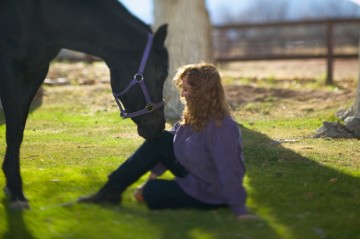
In the eyes of my horse Tabula Rasa, I came to see human dysfunctions as surface scintillations, dramatic and sometimes irritating to be sure, but certainly not set in stone. Whenever I managed, through grace or sheer stubborn will, to let go of an old pattern and embody a fresh perspective, Rasa would mirror the transformation, welcoming me home to an ever deeper understanding of who I really was. And without the slightest hint of ambition, she would continually up the ante, stretching, relentlessly, my own limited ideas about my place in the world, my calling, my untapped potential, and even, as it turns out, the nature of reality itself. Because the ultimate contradiction, the ultimate paradox Tabula Rasa brought to light involved embracing logic and mystery simultaneously, treating them as equal partners, as twin forms of consciousness. She even went to the trouble of having twin sons in 2002 to underline that point. Her first-born son, Spirit, against all odds, stayed in this world to eventually sire his own daughter Artemis. His identical twin brother, Sanctus, was stillborn. In one outlandish gesture, Rasa gave birth to life and death simultaneously, vividly and forever connecting us to this world and the other. Sometimes late at night, I still catch a glimpse of Spirit’s brother shadowing him, dancing in the moonlight.
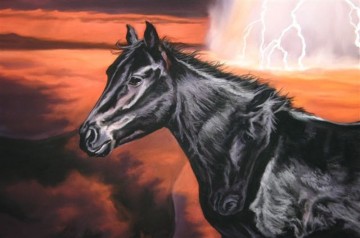
Rasa’s lesson plan for me, and for thousands of people around the world who became her students in one way or another, involved a wildly expanded, inter-disciplinary approach to life. She insisted that we become more effective in navigating the challenges of a concrete, earthly reality, while also exercising our innate yet long-suppressed ability to collaborate with an ephemeral, eternally morphing spiritual reality, to claim our birthright as co-creators in a universe capable of dreaming big dreams. In this effort, Rasa taught us to not just appreciate mystery but to ride it, to use the challenges, frustrations, disappointments and pain of life to exercise a warrior’s courage, not to conquer the known world, but to reach into the fertile darkness of the magnificent void and speak what has never been spoken, write what has never been written, paint what has never been seen, dream what has never been dreamed.
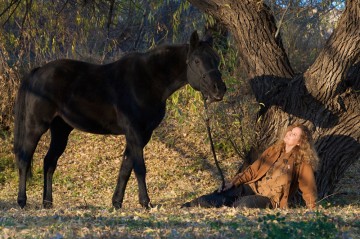
The mystery of creativity and the alchemy of turning pain into inspiration both depend upon accessing what logic can’t touch — without losing your sanity. These are elements of what I came to call “black horse wisdom,” wisdom that’s felt more deeply than it can ever be explained, wisdom we often ignore until some difficulty in life opens up us to other possibilities. In dreams and myths from around the world, the black horse heralds the reassertion of qualities difficult for the well-groomed persona to handle, revolutionary insights and energies that can’t be tamed by polite society. The black horse champions knowledge rejected by the mainstream: instinct, emotion, intuition, sensory and extrasensory awareness, and the human-animal partnership associated with tribal cultures. Science may never be able to dissect this wisdom, to bring it fully into the light of conscious understanding, but through the metaphor of the horse, and through real life interactions with Rasa, I learned to negotiate the outlying areas of human existence, and to a certain extent, map them. For a while, at her urging, I went feral, reveling in the life of a lone artist-adventurer. But the black horse didn’t let me stay there long, emphatically herding me back into the human world, demanding that I translate her silent wisdom into language that twenty-first-century audiences could embrace.
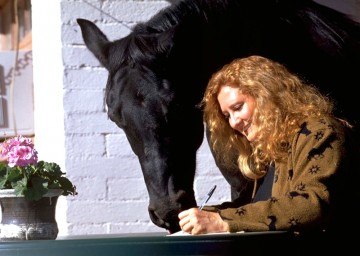
And so in my first book, The Tao of Equus, I told Rasa’s story from this perspective, mixing the earthier, historical and more practical elements of the horse-human relationship with the emotional and spiritual dynamics, struggling to put my most elusive experiences with the black horse into words, fearing all the while that I would be dismissed as crazy, if not actually committed. I was stunned by the power of this approach. Readers from around the world not only wrote me of their own long hidden experiences, they began showing up in person. The black horse stepped forward without hesitation, somehow compelling people to exercise their own intuitive and creative abilities. In her presence, students would be inspired, effortlessly and inexplicably, to draw, paint, write poetry, compose songs and, increasingly, to access a mythic otherworld where past, present and future merged in outlandish yet profound visions of possibility.
And then Rasa upped the ante. As people around the world came to study with both of us, I was thrust into what, for me, was the strangest and most frustrating task of all: combining the sensitivity and optimism of the visionary with the fortitude and realism of a leader. Not just any kind of leader, mind you, but one who was expected to be compassionate, innovative and effective simultaneously. In this effort, through much pain and confusion, I was confronted with our culture’s most cherished notions about power and authenticity. Yet to maintain the crucial creative element that attracted people to our work in the first place, I had to keep my heart open, no matter how much pain was involved. I grappled daily with experiences emphasizing that the unusually potent combination of power and authenticity was a serious double-edged sword, so volatile and dangerous when you’re learning how to use it, yet so essential to personal and social transformation. To make matters worse, I was expected to teach people to wield this heavy weapon as I was initially exploring the art form myself. Developing the muscles just to hold the damn thing up, let alone twirl it Samurai-style without cutting my own arm off, took years of conditioning and experimentation.
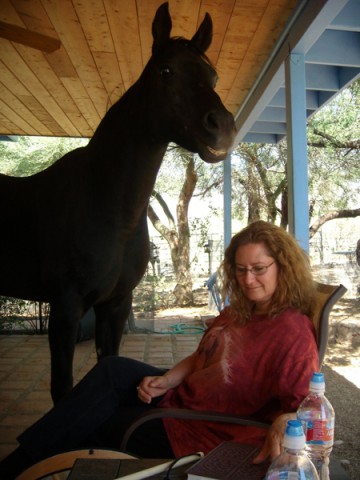
While the pitfalls of power were obvious, I was shocked daily by the myriad ways that people inadvertently injured each other in the name of authenticity. Discovering how people might access and develop their power while retaining sensitivity and creativity, expressing themselves effectively yet considerately, was the ultimate challenge, becoming the topic of a book I never expected to write. In true Rasa fashion, The Power of the Herd: Building Social Intelligence, Visionary Leadership and Authentic Community through the Way of the Horse is an unusually demanding project, combining history, practical methods and scientific research with some rather unusual yet compelling, horse-inspired perspectives on evolution, human culture, and human potential. If that’s not already enough of a challenge, I must also address the visionary element, which seems so out of place in our mechanized world, yet becomes so essential in imagining new ways of living and working together in peace and balance. Our very survival depends upon it.
As Walter Winchell observed, “Leadership is the capacity to translate vision into reality.” Tabula Rasa understood this, insisting that all her students, me included, move ever more skillfully between practical, earthly existence and that strange, amorphous otherworld where the as-yet-unimagined hovers, waiting, always waiting, for someone with the nerve, endurance, ingenuity, and charisma to coax the formless into form. This, she conveyed silently yet eloquently throughout her life, is how we change the world.
And finally last fall, she sent me a dream foreshadowing her death, hitting me, rock-on-head-style, with the sacred imagery of her own fruition — while fully taking into consideration my child-like dependence upon her, my reluctance to let her go. At the same time she hinted at a sudden transformation that would affect other members of the Epona herd, sending messages of hope and trust in the wisdom of what promised to be a challenging turn of events.
(Please click any image on this page for an enlarged view.)
Looking South

Before I share this mythic, strangely prescient dream, it’s important to catch up on a few facts. In 2009, our business, like many others, suffered from a sudden downturn in the economy, making it impossible for us to support a full service retreat center at Apache Springs Ranch. Members of the Eponaquest herd dispersed to a variety of smaller properties. I managed to retain a dozen horses, eleven of which moved with me to a secluded rental property in Vail, Arizona. I decided to board the twelfth, our lanky yet serene, open-hearted gelding Dakota, at Shelley Rosenberg’s ranch, as he had fallen in love with her mare Laramie while both lived at Apache Springs. In his late-20s, Dakota seemed to rely on Laramie for continued well-being, and I didn’t want to break the pair up.

Tigger and Amigo were donated to a therapeutic riding program for teenage girls, where they were groomed and fawned over with great enthusiasm. Kairos and Beau went to California and Texas respectively, thriving in the care of two sensitive horsewomen who had attended a number of advanced Eponaquest programs. The rest of our expert horse facilitators — Max, Timey, and Cindy — were either adopted by or already belonged to senior faculty members Shelley Rosenberg, Mary-Louise Gould, and Carol Roush, who were holding Eponaquest workshops at other regional facilities. No matter how often we tried to retire the elders, however, all of the horses continued to excel as teachers in various contexts. Max in particular would become depressed whenever we tried to excuse him from work, immediately brightening up when Shelley let him interact with clients once again, even though the 25-year-old Arabian was having increasing trouble getting up whenever he laid down. Timey also was a steady and regular guide in a variety of workshops and trainings at Shelley’s ranch, teaching both active and reflective activities with sensitivity and skill. In the photo, he and Eponaquest instructor Mimi Meriwether are ending an amazing dance that left few eyes dry. And Cindy was in her 30s, still reveling in the work even at her advanced age!
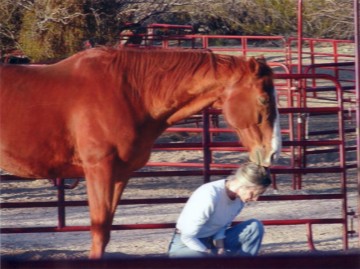
The year I rented the Vail house was incredibly healing in many ways. Cradled by mountains on three sides, this scenic, horseshoe-shaped valley was lined with hundreds of towering saguaro cactuses guarding the stillness like sentinels from some alien otherworld. Rasa and I would go on gentle walks at sunset, enjoying large stretches of privacy between small yet powerful workshops. The only anxiety I felt during that time concerned Rasa’s declining health. Her right back stifle, which had developed an OCD lesion, ending any hope of a conventional riding career at age three, was becoming increasingly arthritic. When she was first diagnosed in the mid-1990s, one veterinarian had told me that even with the latest therapeutic support, she would likely only live into her teens.
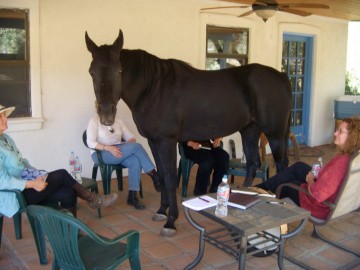
And so as Rasa turned 18 in 2009, I was grateful for every day we spent together. She was becoming noticeably stiffer in her right back leg as her left back hoof showed signs of stress from compensating all those years. At the same time, she was becoming ever more powerful as a teacher. Free to move around the property at will, she would reach out to support students, often volunteering to join our discussions on the porch when she could have been grazing in the back yard. She engaged people in impromptu healing and visionary sessions, sometimes transforming perplexing, longstanding issues in a single afternoon. During several different Black Horse Wisdom workshops, always at the same crucial moment in the schedule, she would move around to touch each participant, then emphatically stand in the center of the circle. Clients used the word “anointed” to describe the way they felt in the wake of such a gesture. Rasa was operating at a level far beyond anything I could have trained her to do. Her timing was so impeccable, her actions so deliberate and intelligent, that it felt, at times, like being in a Disney movie where the animals are imbued with a touch of magic, outshining the human characters in wisdom, ingenuity and compassion.
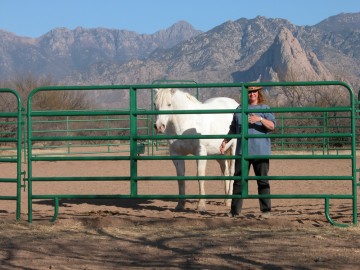
And then she began to do something very strange during our evening strolls, walking faster, more urgently, leading me farther and farther away from the herd as if she was searching for something, always looking south, seemingly trying to figure out how to get somewhere very specific. Several months later, when my husband Steve and I found a scenic horse property we could afford on Eagle Way in Amado, AZ, I realized that from the Vail rental, Rasa was looking directly at Elephant Head mountain, a massive, vaguely pyramid-shaped, cathedral-like structure that towered over our new home.
Dreamtime Return
The very first night we stayed at Eagle Way, Steve fell asleep watching TV in the living room as I drifted off in one of the bedrooms amidst stacks of moving boxes, content that we would finally have a spacious, permanent, horse-friendly home of our own, one which could accommodate a growing herd. I was soon overtaken by what psychiatrist Carl Jung would call a “big dream,” a vivid, emotionally-charged, hyper-real vision filled with archetypal images.
The horses had arrived at Eagle Way and were happily trotting about, figuring out who would live where, excited by their new surroundings. Suddenly the tightly knit group calmed down, parting with reverence to let Rasa pass through the center of the herd. My breath caught in my throat as she walked slowly toward me, concentrating as if every step mattered. Rasa’s entire face was painted with white chalk, with an intricate, mandala-like design in the center of her forehead. Immediately, I associated this powerful yet unsettling image with shamanic initiation, remembering that Australian Aboriginal tribesmen and certain sages from India paint their faces in a similar way during rituals.
Rasa’s intense, ceremonial demeanor conveyed a message I wasn’t quite ready to embrace. She would be leaving this world soon. I fell to the ground sobbing, whining like a little child: “Please, please, please don’t leave me,” I begged. “Don’t you love me? Don’t leave me if you love me.”
When I looked up again, Rasa was standing on a mesa-like ridge to the South, overlooking the herd, our home, the entire valley, staring down with a peaceful detachment that still somehow conveyed warmth and concern. Then, out from behind the mesa, a woman wearing a white horse-head mask moved gracefully toward me. She began whispering in my left ear of things to come, the details of which I couldn’t quite remember upon waking. The overriding theme, however, was clear. I was to trust in an unexpected turn of events without question. I would understand the wisdom of this challenge as the future unfolded. I nodded, looking up with Rasa, her face still painted white, as if she was transforming black horse wisdom into something more conscious, more powerful, more pure as she prepared to leave this world.
For some reason, I looked east, toward the Santa Rita Mountains, and I saw the strangest thing. A huge, drive-in-movie-sized screen was blocking full view of Elephant Head. To the left, the mare-headed woman was standing on a platform, drawing attention to the luminous spectacle being projected on the screen, guarding it somehow, as if she was the gatekeeper. I was entranced by the image of a Celtic-style Otherworld, a soft dirt path winding through a mystical forest, pulsating with light as if the trees themselves were conscious, back-lit by a golden glow in the distance. Several of my horses ran toward the screen, leaped up, jumped into the scene, and galloped down the path, quickly disappearing from view. “No!” I screamed, and then started running. “Wait for me!”
I hurled myself at the screen and slammed into a sturdy wall. I could actually hear my nails screeching black-board-style as I slid down the barrier. Staring up as I touched ground, I saw these words at the bottom of the screen, superimposed over the red-dirt path:
The End
Part I
I woke up suddenly, huffing and puffing like I had been running at full speed, my chest pounding so hard and fast I thought I was having a heart attack. The dream was so vivid, so magical yet disturbing that I woke Steve up at 2 a.m. to discuss it, hoping that if I could interpret it symbolically and work with it archetypally, I could avoid letting it bleed into this world and influence Rasa’s life directly.

Over the next month, I told several staff members and friends about the dream, but I avoided telling workshop participants. If Rasa was indeed planning to leave this world soon, I didn’t want the news to affect her students’ experience, as she continued to work with a variety of clients in ever more powerful ways. Three times over the fall and winter months various life-threatening physical conditions emerged, and each time, I feared that I was losing her. But, with the help of skillful veterinarians and energy workers, she would recover, take a little time off, and then emphatically reach out to people, seeming to take great joy and satisfaction in her work. I was thrilled when we celebrated her twentieth birthday in March. During the Rasa Dance workshop in April, she surprised me by dancing with all four participants, one right after the other, showing no signs of pain or fatigue. These were her last dances on this earthly plane.
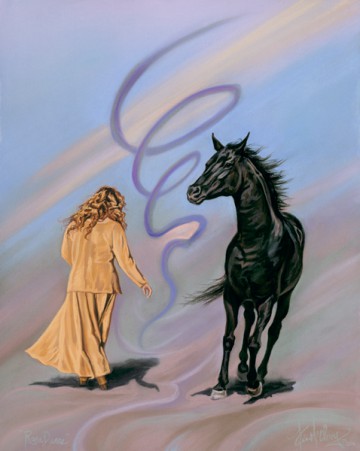
During her final Black Horse Wisdom workshop, she also inspired a talented young musician to reclaim her voice and begin composing again. Belgium-based singer-songwriter Sanna Heijnis had become jaded by some negative experiences in the music business. One night, simply relaxing in the moonlight after an extended journeying experience with the horses, she was delighted when Rasa came up to her, touching her affectionately, then wandering off to mill around the property. (I was in the habit of turning Rasa loose for an hour or two at the end of each day.) The words and the melody came easily to Sanna, opening up a desire to write several other songs over the coming weeks, including one for Max, whom she had ridden at Shelley’s ranch, and one titled “The Master of Sadness,” based on an image/essay on sadness and grief from the Way of the Horse wisdom cards.
Music
Suggestion: Listen to the first three songs, perhaps scrolling back through the photos of Rasa, Max, Dakota, Timey and Shadowfax above. Then play the atmospheric wordless vocal “Rasa Dreams: Lonely Mountain Theme” while reading the next section.
Rasa’s Song
Master of Sadness
The Max Song
Rasa Dreams: Lonely Mountain Theme
The Mystery of the Herd
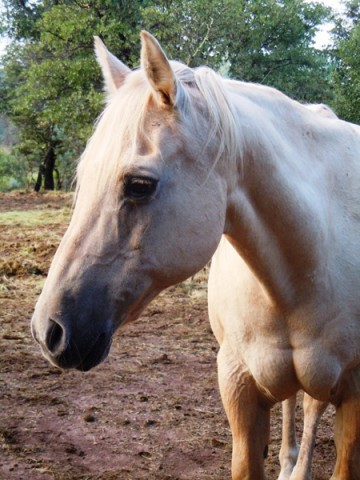
Sanna, who joined the AP 16 apprenticeship class, returned to Eponaquest at Eagle Way for her second week of the training in May, arriving early to record these songs at Steve’s studio. As we played the music for her classmates on Saturday, May 7, tears came to my eyes. Shelley had been faced with the difficult decision to euthanize Max a couple of weeks earlier as he was no longer able to stand up on his own after laying down at night. Cindy had also passed away, on Easter morning. Her owner, Eponaquest faculty member Carol Roush, found the 34-year-old palomino mare lying in the pasture, seemingly suffering from a stroke. Waiting for the vet to arrive, Carol had time to sit quietly with Cindy, thanking her for all of her years of service and deep friendship. (The mare was 102 in human years!) And based on my own vet’s recommendation, I had just made the decision to euthanize 27-year-old Dakota, who was having trouble eating and standing up each morning, in part because of a fast-progressing neurological condition. The appointment was set for the following Thursday, May 12. With our loyal elders moving on, “The Master of Sadness” in particular was a song we all could resonate with.
But Dakota was not to be the only horse leaving us that week. On Sunday, the 8th, Shelley had to rush Mary-Louise’s beloved horse Timey to the vet as he suddenly, unexpectedly colicked. The doctor was not able to save him. That same day, Rasa showed up incredibly lame in her right back stifle and her left back hoof. It was like her entire hind end was shutting down. Still, she was present and engaged, appreciative of our efforts to control her pain with significant drugs prescribed by the vet as we arranged an appointment for the following day. I sat out with Rasa in the moonlight, continuing to check on her throughout the night, reluctantly revisiting the details of a dream foreshadowing her own empowered yet inevitable passing. And it suddenly struck me that several herd members had jumped into the Otherworld, one right after the other, at the end of that vision. I braced myself for one more loss as I remembered the mare-headed woman’s whispered advice to trust in the wisdom of a strange turn of events.
Shelley, still dealing with the shock and grief of Timey’s sudden passing, as well as the loss of two older original Epona herd members in the weeks before, trailered Rasa to the vet as I continued teaching the AP 16 class. And then the call I had long been dreading came. “I’m so sorry, Linda,” Dr. Barbara Page said. “There is nothing more we can do for her.” X-rays showed that Rasa’s left back hoof had severely foundered from the increasing stress of compensating for her right back leg all those years. The coffin bone was coming through the hoof wall, creating a condition so painful, it would have been cruel to trailer her back to the ranch to say goodbye to her children and be euthanized at home. As faculty member Nancy Coyne took over the AP class, I jumped in the truck, speeding to Adobe Veterinary Center to say my final goodbyes. (Everyone insisted that I let staff member Kathleen McGarry drive me, though I resisted at first, wanting to be alone. I was ultimately grateful for her sensitive, supportive presence.)
At the last minute, I somehow thought to grab my boom box and Sanna’s newly recorded CD of the song she wrote for Rasa. And as I sat with my beautiful, regal, yet noticeably weary mare, I said goodbye to her with the music she inspired playing in the background. Despite being heavily drugged, Rasa pricked up her ears when Sanna sang her name, looked directly at the player, licked and chewed and let out a big sigh.
Ceremony and Remembrance
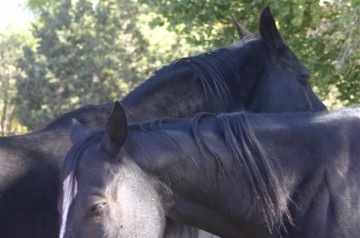
The class of AP 16 was present for Rasa’s funeral that afternoon. We laid Rasa’s body at a quiet, secluded site with a view of Elephant Head and that mesa-like formation to the South that we began calling Rasa Ridge. We wove roses into her mane, and thanked her. Sanna somehow was able to sing Rasa’s song, live, to all of us. Shelley and our current barn manager, Elysa Ginsburg, brought sons Indigo Moon and Spirit, both sired by Midnight Merlin, to see her one last time. We also brought Comet, Rasa’s long-time herd sister, and Orion, Comet’s son by Merlin, to say goodbye. All of the horses approached Rasa, touching her face, sniffing and caressing her ears. Comet breathed into Rasa’s nostrils numerous times, as if trying to jump start her now-silent companion’s breathing.
And then, after everyone left, Steve and I sat with Rasa’s still beautiful form, stroking her shiny black coat as the sun slowly set, sharing memories of our many years together. “We are different people because of her,” Steve said, tears flowing down his cheeks. “We know so much more, about life, about relationships and possibilities, things we never would have understood so deeply, or in some cases even glimpsed, without her.”
Later that evening, when the man with the backhoe arrived by moonlight, he and Steve helped me down into the depths of the earth that would become Rasa’s final resting place. I had been collecting dried rose petals for years, storing them in plastic bags for no particular reason. I had petals from Apache Springs Ranch, from the Vail house, and most recently from a beautiful rose bush at Eagle Way. I lined the grave with multi-colored petals from all three places. In the center, I stretched out a flag with the Eponaquest symbol emblazoned on it, one that our last apprenticeship class at Apache Springs had given us. I placed a copy of all three of the books the black mare had inspired at the edges of the flag, spread the horse cards around, and included a lock of my own hair as an exchange for her tail, which now rests on the ancestor’s table in our house. In the coming days, Steve would construct a simple yet artful stone memorial with the figure of an angel riding a horse resting on top.
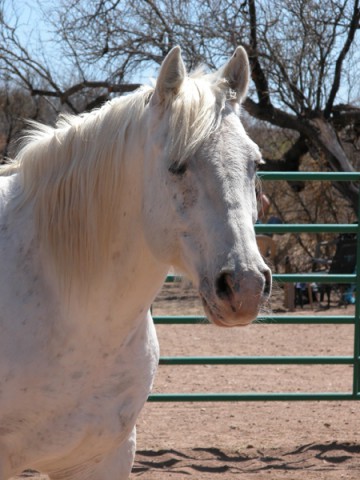
Later that week, the AP 16 class said goodbye to Dakota with as much reverence and poise as they offered Rasa. Nine days later, our AP 15 class returned for their second week. At a simple sunset memorial on May 21, staff and apprentices told stories of how all of the elders who had recently passed affected their lives. We played Sanna’s songs. And, finally, on Sunday, May 22, we lost one more herd member. Shadowfax, my beloved leopard appaloosa and master teacher, colicked suddenly, like Timey had two weeks earlier in Sonoita. We rushed him to the vet, but the situation was dire. After complications from a previous colic surgery four years earlier, I decided I couldn’t put him through that stress again. The vet emphasized that we were lucky to have those additional years with him. Shadowfax was euthanized and brought back to us, where apprentices, staff and herd members were able to say goodbyes before he was buried next to Rasa.
Shadowfax had an uncanny ability to interact with clients in ways that evoked the characteristics of a well-adjusted father figure. He had, unprompted by me, brought this theme up regularly, healing, through simple yet profound interactions, some of the trauma people had experienced with abusive, neglectful, or simply absent fathers. He was one of the few stallions I’ve met who could be turned out with his weanling sons, setting gentle boundaries with them, playing with them, and affectionately licking their faces. We still have his son Sage with us, an unusually secure and well-rounded teacher who no doubt benefitted from expert fathering at a time when most horses never meet their sires. That Shadowfax synchronistically died on May 22, my own late-father’s birthday, did not escape me. Neither did my fond memories of one of Shadowfax’s last clients dancing with him to a very special song, Luther Vandross’s “Dance with my Father.”
I do not pretend to understand the timing of these transitions. Max, Cindy, Timey, Rasa, Dakota, and Shadowfax all died within less than a month of each other, at different properties, for completely different reasons, leaping into the Otherworld one right after the other. Someday, I hope that I may grasp the wisdom behind these events, as the mare-headed woman in my dream promised. For now, I hope she simply closes the gate and shuts off the projector, at least for a while.
In the meantime, I was obliged to let go of another soulful family member. On May 31, exactly one year to the day that our beloved bear-like dog Raven died at an advanced age, our beautiful dog Nala transitioned after nearly 16 loyal years. Oddly enough, I could appreciate the timing. In fact, I hope that her legendary herding instincts are being put to good use “over there,” namely by nipping at the heels of any other Eponaquest horses who might try to test that otherworldly gate, sending them back to our living, breathing herd.
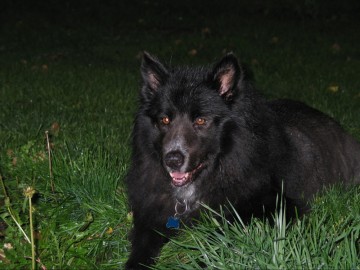
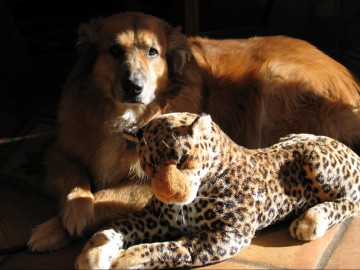
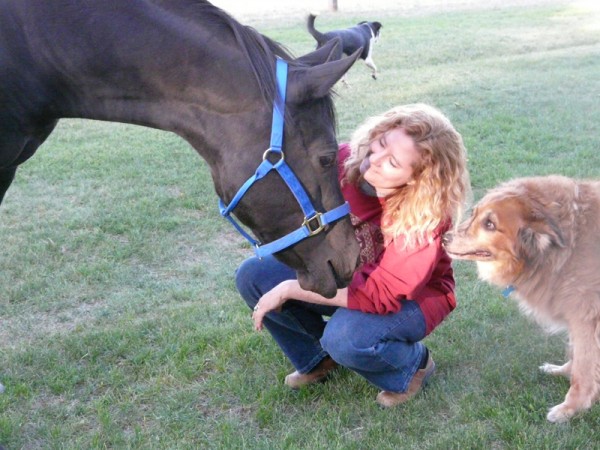
Rasa Ridge
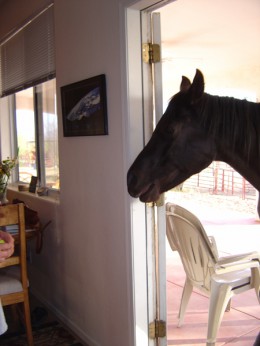
Since she left us well over a month ago, I have had a number of compelling encounters with Rasa, but there is always a small part of me that’s skeptical of such connections, wondering if I’m engaging in some sort of vivid wishful thinking. Still, she was the mare who originally taught me to connect with the Horse Ancestors, a form of non-local communication I have found immensely useful, and have taught to others with impressive results. I don’t know why I’m so surprised by this, but I seem to have ready access to her spirit, as if Rasa is still standing on that ridge between the worlds, watching over us. Our relationship continues to evolve, offering tremendous comfort, insight and support. Sometimes she initiates the communication, herding me toward a decidedly horse-like agenda. I will share some of these intriguing messages in future workshops and newsletters.
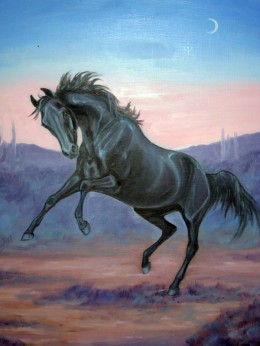
And I invite you to continue to share any dreams, memories, artwork or reflections that Rasa has, or will, inspire in you.
(Thanks to all of you who sent emails after Rasa’s passing.)
Loving Validation
I wish to close this extensive tribute with an email from a client who recently attended a seminar at Eagle Way led by Elysa Ginsburg and Kathleen McGarry. While Tori had received the brief website announcement in May that Rasa had passed away, she had never met the mare. We had not yet announced, nor did Elysa or Kathleen discuss, the other herd members who had recently died, respecting my wishes to hold off until I could share this information with the wider community first. Neither did they discuss Rasa during that jam-packed introductory workshop, let alone offer specific information on her personality or leadership style. That Tori somehow accurately picked up on these details while interacting with one of our horses, El Dia, offered my skeptical logical brain some validation that the message was legitimate. As you’ll see in the excerpt below, Tori was also reluctant to share the information as it came from an intuitive connection that she didn’t quite expect or understand.
Thank you for a wonderful experience at Eponaquest last weekend. I got a lot out of the human and horse interaction. I continue to work on boundaries and I am reluctant to share the following but thought I would anyways. Please take it for what it is worth:
I had a message from El Dia about a group of horses that have passed. Especially one black horse that was close to Linda/had a personality like Linda/energy like Linda or something. This horse is a leader, but very feminine and receptive. She is charismatic and says she is going to carry on what Linda is doing here with people with horses there. She really has a lot of love and gratitude for Linda. That’s a summary — strange huh? Does this make any sense?
Yes, I was happy to report, it makes perfect sense, though it doesn’t lessen the mystery of how receiving such a message is even possible. For now, we must simply trust that the horses are exercising, once again, those twin forms of consciousness in their human students — El Dia in this world, and Rasa, my dear friend, from the golden light of an otherworldly path that we too, one day, must all travel on our way to greener pastures.
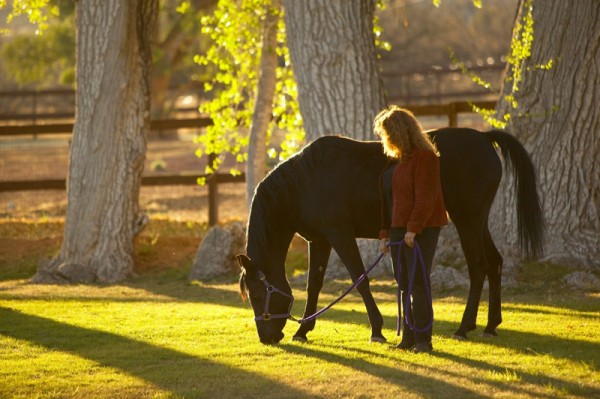
I thought back to the dream, to my own childish insistence that if Rasa loved me, she wouldn’t leave me. My heart swelled at the realization that somehow, through a woman she’d never met, Rasa was reaching out to me, emphasizing that loving and leaving are not mutually exclusive.
If anything I feel her love and wisdom flowing through me, stronger than ever. And I am grateful.
